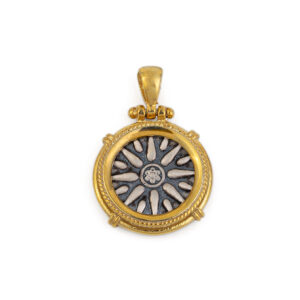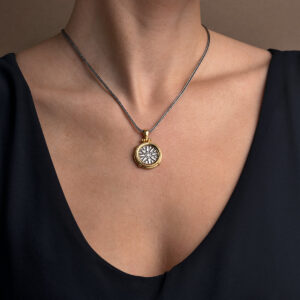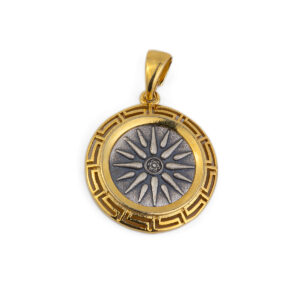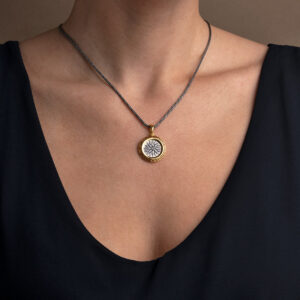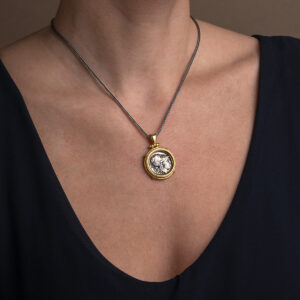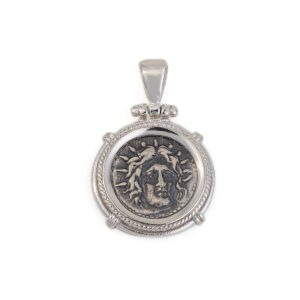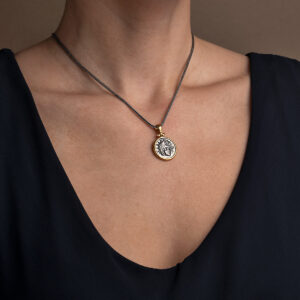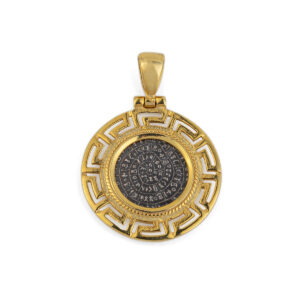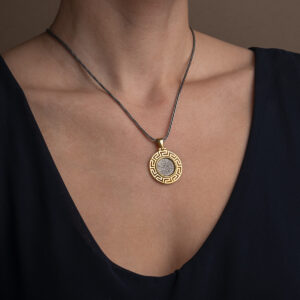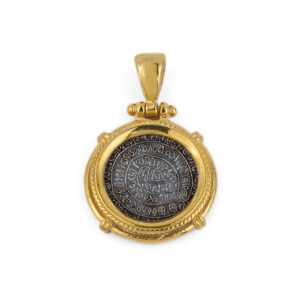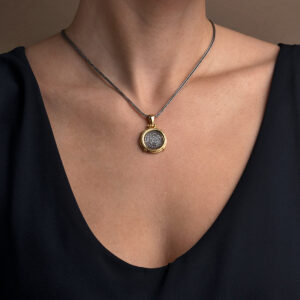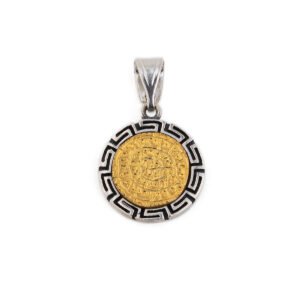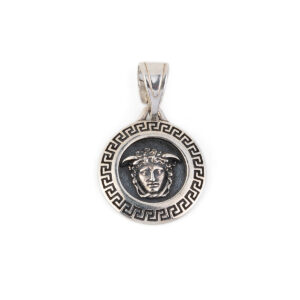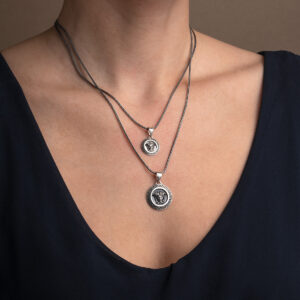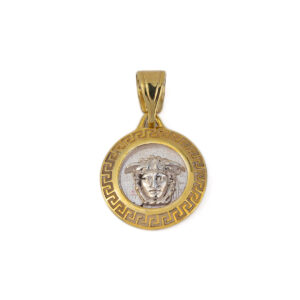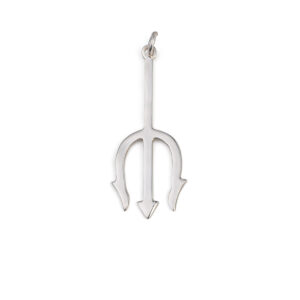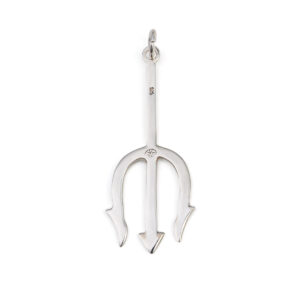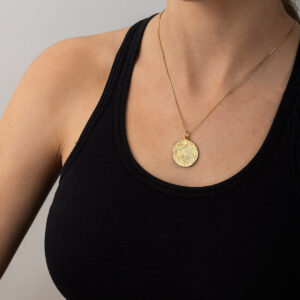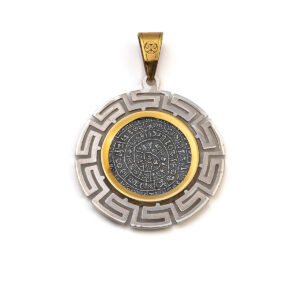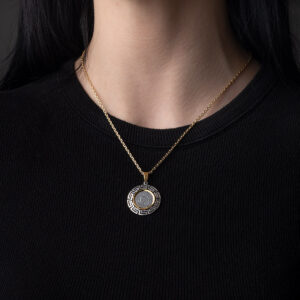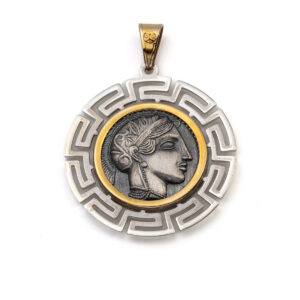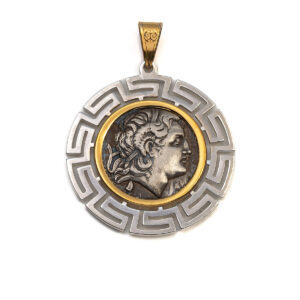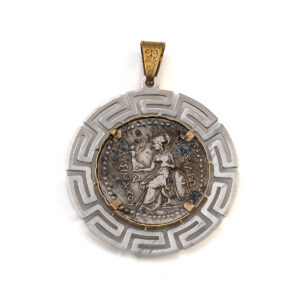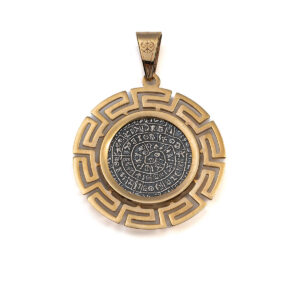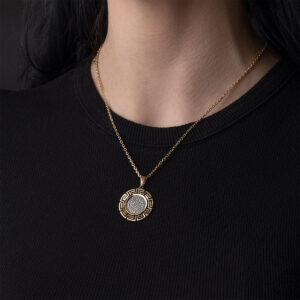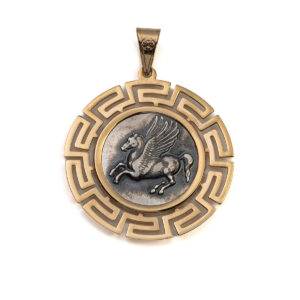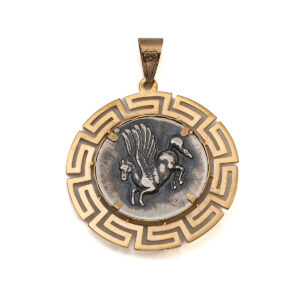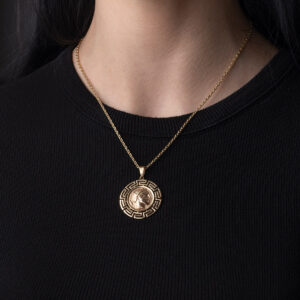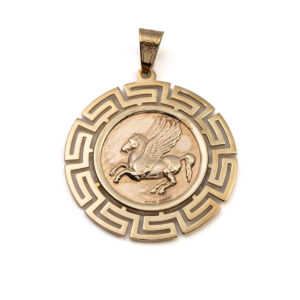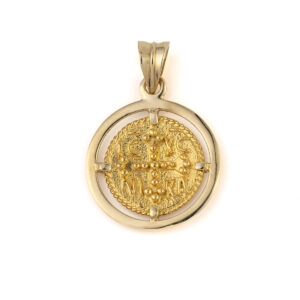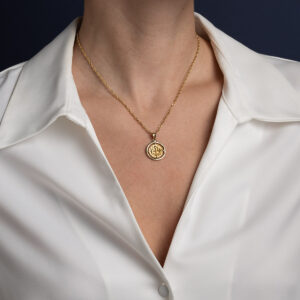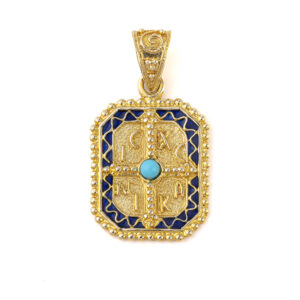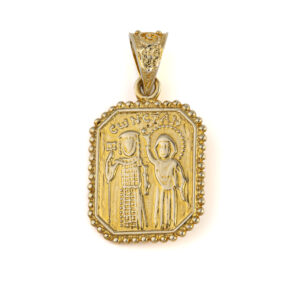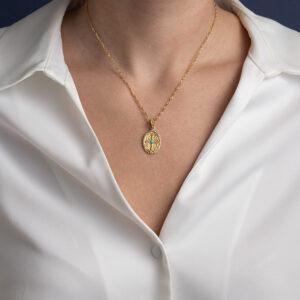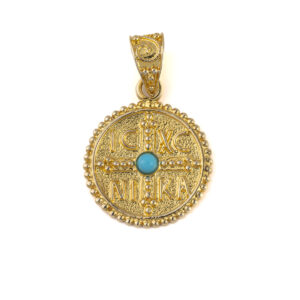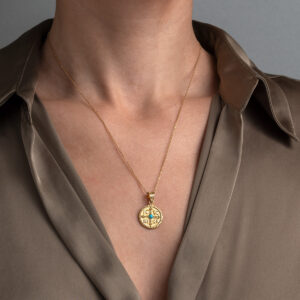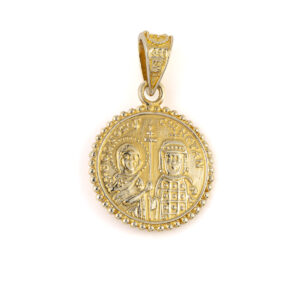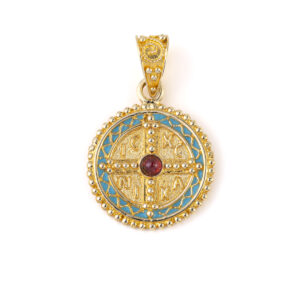Pendants
Vergina Sun Pendant – Sterling Silver and Gold Plated
This pendant illustrates the Vergina symbol.
Made of 925 sterling silver and gold plated.
Handmade in Greece. Explore Heritage Collection
History
The Vergina Sun also known as the “Star of Vergina”, or “Macedonian Star” is a rayed solar symbol appearing in ancient Greek art. The Vergina Sun proper has sixteen triangular rays. The name “Vergina Sun” became widely used after the archaeological excavations in and around the small town of Vergina, in northern Greece, during the late 1970s. In older references, the name “Argead Star” or “Star of the Argeadai” is used for the Sun as the royal symbol of the dynasty of Macedon. There it was depicted on a golden larnax found in a 4th-century BC royal tomb belonging to either Philip II or Philip III of Macedon, the father and half-brother of Alexander the Great, respectively.
Greek Key Vergina Sun Pendant – Sterling Silver and Gold Plated
This pendant illustrates the Vergina symbol.
Made of 925 sterling silver and gold plated.
Handmade in Greece. Explore Heritage Collection
History
The Vergina Sun also known as the “Star of Vergina”, or “Macedonian Star” is a rayed solar symbol appearing in ancient Greek art. The Vergina Sun proper has sixteen triangular rays. The name “Vergina Sun” became widely used after the archaeological excavations in and around the small town of Vergina, in northern Greece, during the late 1970s. In older references, the name “Argead Star” or “Star of the Argeadai” is used for the Sun as the royal symbol of the dynasty of Macedon. There it was depicted on a golden larnax found in a 4th-century BC royal tomb belonging to either Philip II or Philip III of Macedon, the father and half-brother of Alexander the Great, respectively.
Athena – Stater of Corinth Pendant – 925 Sterling Silver Gold Plated
Made of 925° sterling silver and gold plated.
Handmade item. Explore Coins Collection
This Ancient Greek coin represents Athena Chalinitis on the front side and the inscription “ΑΛΕΞΑΝΔΡΟΥ” on the backside.
Athena – Stater of Corinth
This silver stater of Corinth depicts the head of Athena Chalinitis.
Helios Sun Pendant – Sterling Silver
Made of 925° sterling silver.
Handmade item. Explore Coins Collection
Handmade pendant, inspired by an ancient Greek tetradrachm coin of Rhodes.
This Ancient Greek coin illustrates Helios Sun God on the one side and the flower rhodon (rose), a symbol of Rhodes on the other. The inscription reads : “RHODION” in Greek fonts.
Helios, in Greek mythology, is the god and personification of the Sun, often depicted in art with a radiant crown and driving a horse-drawn chariot through the sky.
Helios Sun Pendant – 925 Sterling Silver Gold Plated
Made of 925° sterling silver and gold plated.
Handmade item. Explore Coins Collection
Handmade pendant, inspired by an ancient Greek tetradrachm coin of Rhodes.
This Ancient Greek coin illustrates Helios Sun God on the one side and the flower rhodon (rose), a symbol of Rhodes on the other. The inscription reads : “RHODION” in Greek fonts.
Helios, in Greek mythology, is the god and personification of the Sun, often depicted in art with a radiant crown and driving a horse-drawn chariot through the sky.
Greek Key Phaistos Disc Pendant – Sterling Silver and Gold Plated
Made of 925° sterling silver and gold plated.
Handmade item. Explore Phaistos Disc Collection
The Phaistos Disc is a disk of fired clay from the Minoan palace of Phaistos on the island of Crete. Now, the island of Crete is part of modern Greece. The disc was discovered in 1908 by the Italian archaeologist Luigi Pernier in the Minoan palace site of Phaistos. While it is not clear that it is a script, most attempted decipherments assume that it is; most additionally assume a syllabary, others an alphabet or logography or a calendar. The Malia honeybee pendant was discovered at Chryssolakkos, of the Minoan Palace of Malia on the island of Crete, and is thought to date to c.1800 BC. The named Chryssolakkos means the “pit of gold” because of the precious objects that the farmers used to find there. The Minoan Palace is situated 3 km east of Malia town and is the third most significant known Minoan Palace after Knossos and Phaistos. This pendant is in the shape of two bees, or wasps, storing away a drop of honey in a comb and is one of the most famous exhibits in the Heraklion Museum.
Phaistos Disc Pendant – Sterling Silver and Gold Plated
Made of 925° sterling silver and gold plated.
Handmade item. Explore Phaistos Disc Collection
The Phaistos Disc is a disk of fired clay from the Minoan palace of Phaistos on the island of Crete. Now, the island of Crete is part of modern Greece. The disc was discovered in 1908 by the Italian archaeologist Luigi Pernier in the Minoan palace site of Phaistos. While it is not clear that it is a script, most attempted decipherments assume that it is; most additionally assume a syllabary, others an alphabet or logography or a calendar. The Malia honeybee pendant was discovered at Chryssolakkos, of the Minoan Palace of Malia on the island of Crete, and is thought to date to c.1800 BC. The named Chryssolakkos means the “pit of gold” because of the precious objects that the farmers used to find there. The Minoan Palace is situated 3 km east of Malia town and is the third most significant known Minoan Palace after Knossos and Phaistos. This pendant is in the shape of two bees, or wasps, storing away a drop of honey in a comb and is one of the most famous exhibits in the Heraklion Museum.
Phaistos Disc and Minoan Bees Pendant – 925 Sterling Silver and Gold Plated
Made of 925° sterling silver and gold plated.
Handmade item. Explore Phaistos Disc Collection
The Phaistos Disc is a disk of fired clay from the Minoan palace of Phaistos on the island of Crete. Now, the island of Crete is part of modern Greece. The disc was discovered in 1908 by the Italian archaeologist Luigi Pernier in the Minoan palace site of Phaistos. While it is not clear that it is a script, most attempted decipherments assume that it is; most additionally assume a syllabary, others an alphabet or logography or a calendar. The Malia honeybee pendant was discovered at Chryssolakkos, of the Minoan Palace of Malia on the island of Crete, and is thought to date to c.1800 BC. The named Chryssolakkos means the “pit of gold” because of the precious objects that the farmers used to find there. The Minoan Palace is situated 3 km east of Malia town and is the third most significant known Minoan Palace after Knossos and Phaistos. This pendant is in the shape of two bees, or wasps, storing away a drop of honey in a comb and is one of the most famous exhibits in the Heraklion Museum.
Medusa Pendant – Gold Plated Pendant
Made of 925° sterling silver and gold plated.
Handmade item. Explore Heritage Collection
Medusa, in Greek mythology, the most famous of the monster figures known as Gorgons, is generally described as a winged female with living venomous snakes in place of hair; unlike the Gorgons, she was sometimes represented as very beautiful. According to Hesiod and Aeschylus, she lived and died on an island named Sarpedon, somewhere near Cisthene. Medusa was beheaded by the hero Perseus, who thereafter used her head, which retained its ability to turn onlookers to stone, as a weapon until he gave it to the goddess Athena to place on her shield. according to another account; Perseus buried it in the marketplace of Argos. The Labyrinth in ancient Greece was an elaborate, confusing structure designed and built by the legendary artificer Daedalus for King Minos of Crete at Knossos. Its function was to hold the Minotaur. the Minotaur is a mythical creature portrayed in Classical times with the head of a bull and the body of a man. The Minotaur was eventually killed by the Athenian hero Theseus.
Medusa Pendant – Sterling Silver
Made of 925° sterling silver.
Handmade item. Explore Heritage Collection
Medusa, in Greek mythology, the most famous of the monster figures known as Gorgons, is generally described as a winged female with living venomous snakes in place of hair; unlike the Gorgons, she was sometimes represented as very beautiful. According to Hesiod and Aeschylus, she lived and died on an island named Sarpedon, somewhere near Cisthene. Medusa was beheaded by the hero Perseus, who thereafter used her head, which retained its ability to turn onlookers to stone, as a weapon until he gave it to the goddess Athena to place on her shield. according to another account; Perseus buried it in the marketplace of Argos. The Labyrinth in ancient Greece was an elaborate, confusing structure designed and built by the legendary artificer Daedalus for King Minos of Crete at Knossos. Its function was to hold the Minotaur. the Minotaur is a mythical creature portrayed in Classical times with the head of a bull and the body of a man. The Minotaur was eventually killed by the Athenian hero Theseus.
Medusa Pendant – 925 Sterling Silver
Made of 925° sterling silver.
Handmade item. Explore Heritage Collection
Medusa, in Greek mythology, the most famous of the monster figures known as Gorgons, is generally described as a winged female with living venomous snakes in place of hair; unlike the Gorgons, she was sometimes represented as very beautiful. According to Hesiod and Aeschylus, she lived and died on an island named Sarpedon, somewhere near Cisthene. Medusa was beheaded by the hero Perseus, who thereafter used her head, which retained its ability to turn onlookers to stone, as a weapon until he gave it to the goddess Athena to place on her shield. according to another account; Perseus buried it in the marketplace of Argos. The Labyrinth in ancient Greece was an elaborate, confusing structure designed and built by the legendary artificer Daedalus for King Minos of Crete at Knossos. Its function was to hold the Minotaur. the Minotaur is a mythical creature portrayed in Classical times with the head of a bull and the body of a man. The Minotaur was eventually killed by the Athenian hero Theseus.
Medusa Pendant – 925 Sterling Silver and Gold Plated Pendant
Made of 925° sterling silver and gold plated.
Handmade item. Explore Heritage Collection
Medusa, in Greek mythology, the most famous of the monster figures known as Gorgons, is generally described as a winged female with living venomous snakes in place of hair; unlike the Gorgons, she was sometimes represented as very beautiful. According to Hesiod and Aeschylus, she lived and died on an island named Sarpedon, somewhere near Cisthene. Medusa was beheaded by the hero Perseus, who thereafter used her head, which retained its ability to turn onlookers to stone, as a weapon until he gave it to the goddess Athena to place on her shield. according to another account; Perseus buried it in the marketplace of Argos. The Labyrinth in ancient Greece was an elaborate, confusing structure designed and built by the legendary artificer Daedalus for King Minos of Crete at Knossos. Its function was to hold the Minotaur. the Minotaur is a mythical creature portrayed in Classical times with the head of a bull and the body of a man. The Minotaur was eventually killed by the Athenian hero Theseus.
Reversible Zodiac Pendant – 925 Sterling Silver
Made of sterling silver 925°.
Handmade in Greece.
The chain shown is not included.
Silver creations of Yianni Jewelry, created by Garbis Khacherian, a silversmith trader since 1987.
Explore Yianni Jewellery
Poseidon Trident Pendant – 925 Sterling Silver
Made of 925 sterling silver.
Handmade in Greece
Explore Heritage Collection
History
The trident, which is a spear with three points, or prongs, is the weapon of Poseidon, the god of the sea in classical mythology. Poseidon is often depicted holding the trident, which is associated with his power over the oceans and his ability to control the tides.
Phaistos Disc Pendant 14k Gold
204,00€ – 850,00€A pendant inspired by the ancient disk found in Phaistos.
Made of 14k gold.
Handmade in Greece.
The chain shown is our 14K Gold Chain (not included).
Explore Phaistos Disc Collection
History
The Phaistos Disc is a disk of fired clay from the Minoan palace of Phaistos on the island of Crete. Now, the island of Crete is part of modern Greece. The disc was discovered in 1908 by the Italian archaeologist Luigi Pernier in the Minoan palace-site of Phaistos. While it is not clear that it is a script, most attempted decipherments assume that it is; most additionally assume a syllabary, others an alphabet or logography or a calendar.
Phaistos Disk Coin Pendant Meander Bezel
A pendant inspired by the ancient disk found in Phaistos.
Made of 925⁰ sterling silver and 14k gold.
Handmade in Greece.
The chain shown in the second picture is our Rollo Chain – 925 Sterling Silver and Gold Plated (included).
Explore Phaistos Disc Collection
History
The Phaistos Disc is a disk of fired clay from the Minoan palace of Phaistos on the island of Crete. Now, the island of Crete is part of modern Greece. The disc was discovered in 1908 by the Italian archaeologist Luigi Pernier in the Minoan palace-site of Phaistos. While it is not clear that it is a script, most attempted decipherments assume that it is; most additionally assume a syllabary, others an alphabet or logography or a calendar.
Sterling Silver Pegasus Gold Pendant
295,00€A pendant depicting the mythological winged horse Pegasus.
Made of 14k gold and 925 sterling silver.
The chain shown in the second picture is our Rollo Chain – 925 Sterling Silver and Gold Plated (included).
Handmade in Greece with the finest attention to detail.
Explore Coins Collection
History
Pegasus is a mythical winged divine stallion, and one of the most recognized creatures in Greek mythology. Usually depicted as pure white, Pegasus is a child of the Olympian god Poseidon. Pegasus was caught by the Greek hero Bellerophon, near the fountain Peirene, with the help of Athena and Poseidon. Pegasus allowed Bellerophon to ride him in order to defeat the monstrous Chimera, which led to many other exploits. Bellerophon later fell from the winged horse’s back while trying to reach Mount Olympus. Afterwards, Zeus transformed Pegasus into the eponymous constellation.
Goddess Athena Coin – 14k Gold Sterling Silver
250,00€ – 295,00€One of the most popular ancient Greek coins illustrates Athena’s head on one side and the wisdom owl on the other.
Made of 14k gold and 925 sterling silver.
The chain shown in the second picture is our Rollo Chain – 925 Sterling Silver and Gold Plated (included).
Handmade in Greece.
Explore Coins Collection
Goddess Athena and Owl – Athenian silver tetradrachm
Dracma was the currency used in Greece during several periods in its history. The tetradrachm was an Ancient Greek silver coin equivalent to fourdrachmae in Athens it replaced the earlier “heraldic” type of didrachms and it was in wide circulation from ca. 510 to ca. 38 BC. This coin belongs to the so-called “new style Athenian coins” minted between 166 and 64 B.C. and is considered one of the most popular ancient Greek coins which illustrate the portrait of Goddess Athena on the one side and the wisdom owl on the other. Athena is an ancient Greek goddess associated with wisdom, handicraft, and warfare. Athena was regarded as the patron and protectress of various cities across Greece, particularly the city of Athens, from which she most likely received her name. She’s usually shown in art wearing a helmet and holding a spear. Her major symbols include owls, olive trees, and snakes. Her temples were located atop the fortified Acropolis in the central part of the city. The Parthenon on the Athenian Acropolis is dedicated to her, along with numerous other temples and monuments. Her main festival in Athens was the Panathenaia, which was celebrated in midsummer and was the most important festival on the Athenian calendar. In the classical Olympian pantheon, Athena was regarded as the favorite daughter of Zeus. The owl traditionally accompanies Athena. Because of such association, the owl has been used as a symbol of knowledge and wisdom. The inscriptions contain the city’s “national” appellation (“ΑΘΕ», i.e. “of the Athenians”).
Alexander the Great Pendant Gold and Sterling Silver
250,00€ – 295,00€Α beautiful and timeless Coin Pendant inspired by the ancient Greek tetradrachm coin of Alexander the Great.
Made of 14k gold and 925 sterling silver.
The chain shown is our Rollo Chain – 925 Sterling Silver and Gold Plated (included).
Explore Coins Collection
History
This Ancient Greek coin represents Alexander the Great on one side, and the Lysimachou on the other. The inscription reads : Lysimachou in greek fonts. Alexander the Great the King of Macedonia is considered one of the most important forms of world history. Lysimachus was a Macedonian officer and diadochus of Alexander the Great, who became a basileus in 306 BC, ruling Thrace, Asia Minor and Macedon.
Phaistos Disk 14K Gold Coin Pendant Meander Bezel
A pendant inspired by the ancient disk found in Phaistos.
Made of 925⁰ sterling silver and 14k gold.
Handmade in Greece.
The chain shown in the second picture is our Rollo Chain – 14K Gold ( not included).
Explore Phaistos Disc Collection
History
The Phaistos Disc is a disk of fired clay from the Minoan palace of Phaistos on the island of Crete. Now, the island of Crete is part of modern Greece. The disc was discovered in 1908 by the Italian archaeologist Luigi Pernier in the Minoan palace-site of Phaistos. While it is not clear that it is a script, most attempted decipherments assume that it is; most additionally assume a syllabary, others an alphabet or logography or a calendar.
Pegasus Gold Sterling Silver Coin Pendant
615,00€A pendant depicting the mythological winged horse Pegasus.
Made of 14k gold and 925 sterling silver.
The chain shown is our Rollo Chain – 925 Sterling Silver and Gold Plated (included).
Handmade in Greece with the finest attention to detail.
Explore Coins Collection
History
Pegasus is a mythical winged divine stallion, and one of the most recognized creatures in Greek mythology. Usually depicted as pure white, Pegasus is a child of the Olympian god Poseidon. Pegasus was caught by the Greek hero Bellerophon, near the fountain Peirene, with the help of Athena and Poseidon. Pegasus allowed Bellerophon to ride him in order to defeat the monstrous Chimera, which led to many other exploits. Bellerophon later fell from the winged horse’s back while trying to reach Mount Olympus. Afterwards, Zeus transformed Pegasus into the eponymous constellation.
Alexander the Great 14K Gold and Sterling Silver Coin Pendant
450,00€ – 615,00€Α beautiful and timeless Coin Pendant inspired by the ancient Greek tetradrachm coin of Alexander the Great.
Made of 14k gold and 925 sterling silver.
The chain shown in the second picture is our Rollo Chain – 925 Sterling Silver and Gold Plated (included).
Explore Coins Collection
History
This Ancient Greek coin represent the Alexander the Great on one side, and the Lysimachou on the other. Inscription reads : Lysimachou in greek fonts. Alexander the Great the King of Macedonia is considered one of the most important forms of world history. Lysimachus was a Macedonian officer and diadochus of Alexander the Great, who became a basileus in 306 BC, ruling Thrace, Asia Minor and Macedon.
Athena Coin Pendant – 14k Gold and Sterling Silver
450,00€ – 615,00€One of the most popular ancient Greek coins illustrates Athena’s head on one side and the wisdom owl on the other.
Made of 14k gold and 925 sterling silver.
The chain shown in the second picture is our Rollo Chain – 925 Sterling Silver and Gold Plated (included).
Handmade in Greece.
Explore Coins Collection
Goddess Athena and Owl – Athenian silver tetradrachm
Dracma was the currency used in Greece during several periods in its history. The tetradrachm was an Ancient Greek silver coin equivalent to fourdrachmae in Athens it replaced the earlier “heraldic” type of didrachms and it was in wide circulation from ca. 510 to ca. 38 BC. This coin belongs to the so-called “new style Athenian coins” minted between 166 and 64 B.C. and is considered one of the most popular ancient Greek coins which illustrate the portrait of Goddess Athena on the one side and the wisdom owl on the other. Athena is an ancient Greek goddess associated with wisdom, handicraft, and warfare. Athena was regarded as the patron and protectress of various cities across Greece, particularly the city of Athens, from which she most likely received her name. She’s usually shown in art wearing a helmet and holding a spear. Her major symbols include owls, olive trees, and snakes. Her temples were located atop the fortified Acropolis in the central part of the city. The Parthenon on the Athenian Acropolis is dedicated to her, along with numerous other temples and monuments. Her main festival in Athens was the Panathenaia, which was celebrated in midsummer and was the most important festival on the Athenian calendar. In the classical Olympian pantheon, Athena was regarded as the favorite daughter of Zeus. The owl traditionally accompanies Athena. Because of such association, the owl has been used as a symbol of knowledge and wisdom. The inscriptions contain the city’s “national” appellation (“ΑΘΕ», i.e. “of the Athenians”).
Athena and the Owl of Wisdom Coin Pendant – 14k Gold
945,00€One of the most popular ancient Greek coins illustrates Athena’s head on one side and the wisdom owl on the other.
Made of 14k gold.
Handmade in Greece.
The chain shown in the second picture is our Rollo Chain – 14K Gold (not included).
Explore Coins Collection
Goddess Athena and Owl – Athenian silver tetradrachm
Dracma was the currency used in Greece during several periods in its history. The tetradrachm was an Ancient Greek silver coin equivalent to fourdrachmae in Athens it replaced the earlier “heraldic” type of didrachms and it was in wide circulation from ca. 510 to ca. 38 BC. This coin belongs to the so-called “new style Athenian coins” minted between 166 and 64 B.C. and is considered one of the most popular ancient Greek coins which illustrate the portrait of Goddess Athena on the one side and the wisdom owl on the other. Athena is an ancient Greek goddess associated with wisdom, handicraft, and warfare. Athena was regarded as the patron and protectress of various cities across Greece, particularly the city of Athens, from which she most likely received her name. She’s usually shown in art wearing a helmet and holding a spear. Her major symbols include owls, olive trees, and snakes. Her temples were located atop the fortified Acropolis in the central part of the city. The Parthenon on the Athenian Acropolis is dedicated to her, along with numerous other temples and monuments. Her main festival in Athens was the Panathenaia, which was celebrated in midsummer and was the most important festival on the Athenian calendar. In the classical Olympian pantheon, Athena was regarded as the favorite daughter of Zeus. The owl traditionally accompanies Athena. Because of such association, the owl has been used as a symbol of knowledge and wisdom. The inscriptions contain the city’s “national” appellation (“ΑΘΕ», i.e. “of the Athenians”).
Pegasus Coin Pendant Meander Bezel 14K Gold
945,00€A pendant depicting the mythological winged horse Pegasus.
Made of 14k gold.
Handmade in Greece with the finest attention to detail.
The chain shown in the second picture is our Rollo Chain – 14K Gold (not included).
Explore Coins Collection
History
Pegasus is a mythical winged divine stallion, and one of the most recognized creatures in Greek mythology. Usually depicted as pure white, Pegasus is a child of the Olympian god Poseidon. Pegasus was caught by the Greek hero Bellerophon, near the fountain Peirene, with the help of Athena and Poseidon. Pegasus allowed Bellerophon to ride him in order to defeat the monstrous Chimera, which led to many other exploits. Bellerophon later fell from the winged horse’s back while trying to reach Mount Olympus. Afterwards, Zeus transformed Pegasus into the eponymous constellation.
Alexander the Great 14K Gold Coin Pendant Meander Bezel
945,00€Α beautiful and timeless Coin Pendant inspired by the ancient Greek tetradrachm coin of Alexander the Great.
Made of 14k gold.
The chain shown in the second picture is our Rollo Chain – 14K Gold (not included).
Explore Coins Collection
History
This Ancient Greek coin represents Alexander the Great on one side, and the Lysimachou on the other. The inscription reads Lysimachou in greek fonts. Alexander the Great the King of Macedonia is considered one of the most important forms of world history. Lysimachus was a Macedonian officer and diadochus of Alexander the Great, who became a basileus in 306 BC, ruling Thrace, Asia Minor and Macedon.
Constantinato Pendant – Gold 14K
529,00€A handmade gold Constantinato pendant that depicts a cross on the one side and Saints Constantine and Helena on the other side.
A unique pendant that you can offer to your special ones as a protection gift or buy it for yourself.
Made of 14k gold.
Handmade in Greece.
The chain shown is our 14K Gold Twisted Chain (not included).
Constantinato Rectangle Pendant with Turquoise – Gold 14K
680,00€A handmade gold Constantinato pendant that depicts a cross on the one side and Saints Constantine and Helena on the other side.
A unique pendant that you can offer to your special ones as a protection gift or buy it for yourself.
Made of 14k gold.
Handmade in Greece
Constantinato Oval Pendant with Turquoise – Gold 14K
594,00€A handmade gold Constantinato pendant that depicts a cross on the one side and Saints Constantine and Helena on the other side.
A unique pendant that you can offer to your special ones as a protection gift or buy it for yourself.
Made of 14k gold.
Handmade in Greece.
The chain shown is our 14K Gold Twisted Chain (not included).
Constantinato Pendant with Turquoise – Gold 14K
578,00€A handmade gold Constantinato pendant that depicts a cross on the one side and Saints Constantine and Helena on the other side.
A unique pendant that you can offer to your special ones as a protection gift or buy it for yourself.
Made of 14k gold.
Handmade in Greece.
The chain shown is our Cable Chain in 14K Gold (not included).
Constantinato Pendant with Enamel and Turquoise – 14K Gold
622,00€A handmade gold Constantinato pendant that depicts a cross on the one side and Saints Constantine and Helena on the other side.
A unique pendant that you can offer to your special ones as a protection gift or buy it for yourself.
Made of 14k gold.
Handmade in Greece
Constantinato Pendant with Enamel – 14K Gold
622,00€A handmade gold Constantinato pendant that depicts a cross on the one side and Saints Constantine and Helena on the other side.
A unique pendant that you can offer to your special ones as a protection gift or buy it for yourself.
Made of 14k gold.
Handmade in Greece

